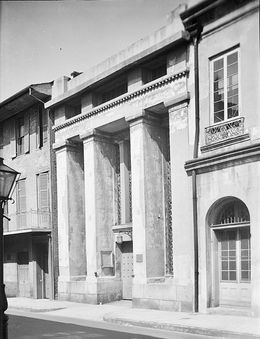New Orleans Arsenal: Difference between revisions
John Stanton (talk | contribs) No edit summary |
John Stanton (talk | contribs) No edit summary |
||
| (6 intermediate revisions by the same user not shown) | |||
| Line 13: | Line 13: | ||
== History == | == History == | ||
During the early 1800s, ordnance stored in New Orleans was kept in rented buildings, and in the 1820s, much of it was moved to the [[Baton Rouge Arsenal]]. The need for an independent New Orleans Arsenal became apparent in the 1830s. | During the early 1800s, ordnance stored in New Orleans was kept in rented buildings, and in the 1820s, much of it was moved to the [[Baton Rouge Arsenal]]. The need for an independent New Orleans Arsenal became apparent in the 1830s. | ||
[[File:New Orleans Arsenal Elevation.jpg|thumb|left| | [[File:New Orleans Arsenal Elevation.jpg|thumb|left|260px|New Orleans Arsenal Building March 1934 Richard Koch, Photographer]] | ||
[[File:New Orleans Arsenal Front.jpeg|thumb|right|250px|New Orleans Arsenal Building in 2020.]] | [[File:New Orleans Arsenal Front.jpeg|thumb|right|250px|New Orleans Arsenal Building in 2020.]] | ||
The site selected for the Arsenal was occupied as early as 1728 by a French guardhouse and prison which was destroyed by fire on 31 Mar 1788. It was rebuilt by the Spanish and again destroyed by fire 8 Dec 1793. It was again rebuilt in connection with the Cabildo in 1795 and was used as a prison or "calaboose" until 1837 when it was demolished on completion of the prison on Orleans Street, which was also demolished. | The site selected for the Arsenal was occupied as early as 1728 by a French guardhouse and prison which was destroyed by fire on 31 Mar 1788. It was rebuilt by the Spanish and again destroyed by fire 8 Dec 1793. It was again rebuilt in connection with the Cabildo in 1795 and was used as a prison or "calaboose" until 1837 when it was demolished on completion of the prison on Orleans Street, which was also demolished. | ||
{{Clr}} | |||
On 25 Feb 1836, Governor S. B. White, of Louisiana, approved an Act of the Legislature authorizing the Arsenal and indicating: | On 25 Feb 1836, Governor S. B. White, of Louisiana, approved an Act of the Legislature authorizing the Arsenal and indicating: | ||
| Line 26: | Line 28: | ||
== Current Status == | == Current Status == | ||
Now part of the Louisiana State Museum in New Orleans. | [[File:New Orleans Arsenal Plaque.jpeg|thumb|left|250px|New Orleans Arsenal Plaque.]] | ||
Now part of the Louisiana State Museum in New Orleans. Access is through the museum. | |||
{{Clr}} | |||
---- | ---- | ||
{| | {| | ||
| Line 70: | Line 75: | ||
[[Category:2020 Research Trip]] | [[Category:2020 Research Trip]] | ||
[[Category:State Arsenals]] | [[Category:State Arsenals]] | ||
[[Category:CSA Arsenals]] | |||
[[Category:Arsenals]] | [[Category:Arsenals]] | ||
[[Category:{{PAGENAME}}]] | [[Category:{{PAGENAME}}]] | ||
[[Category:Starter Page]] | [[Category:Starter Page]] | ||
Latest revision as of 18:43, 1 October 2020
|
New Orleans Arsenal (1846-1914) - A Louisiana State Arsenal first established as New Orleans Arsenal in 1846 in New Orleans, Orleans Parish, Louisiana. Used as an Arsenal up until the U.S. Civil War and thereafter as a military headquarters, a military prison and a police station after the war. After reconstruction, used by the Orleans Artillery and as a state arsenal. Transferred to the Louisiana State Museum in 1914. HistoryDuring the early 1800s, ordnance stored in New Orleans was kept in rented buildings, and in the 1820s, much of it was moved to the Baton Rouge Arsenal. The need for an independent New Orleans Arsenal became apparent in the 1830s.  
The new arsenal building, designed by Dakin and Dakin Architects, was built directly behind the historic Cabildo in New Orleans and was used from 1846 until the Civil War by the Orleans Artillery. In 1860 the Arsenal was used as the headquarters for General P.G.T. Beauregard, (Cullum 942), adjutant general of Louisiana. The Confederates then used the Arsenal to store military supplies until Union troops occupied the city in 1862. Under the Federal occupation, the Arsenal became a military prison. After the war, during the Reconstruction period, the Metropolitan Police occupied the Arsenal. In later years, the Arsenal was used by the reorganized Orleans Artillery and as a state Arsenal. On 15 Mar 1914, the old arsenal was transferred to the Louisiana State Museum. Current Status Now part of the Louisiana State Museum in New Orleans. Access is through the museum.
See Also: Sources:
Links:
Visited: 30 Sep 2020
|